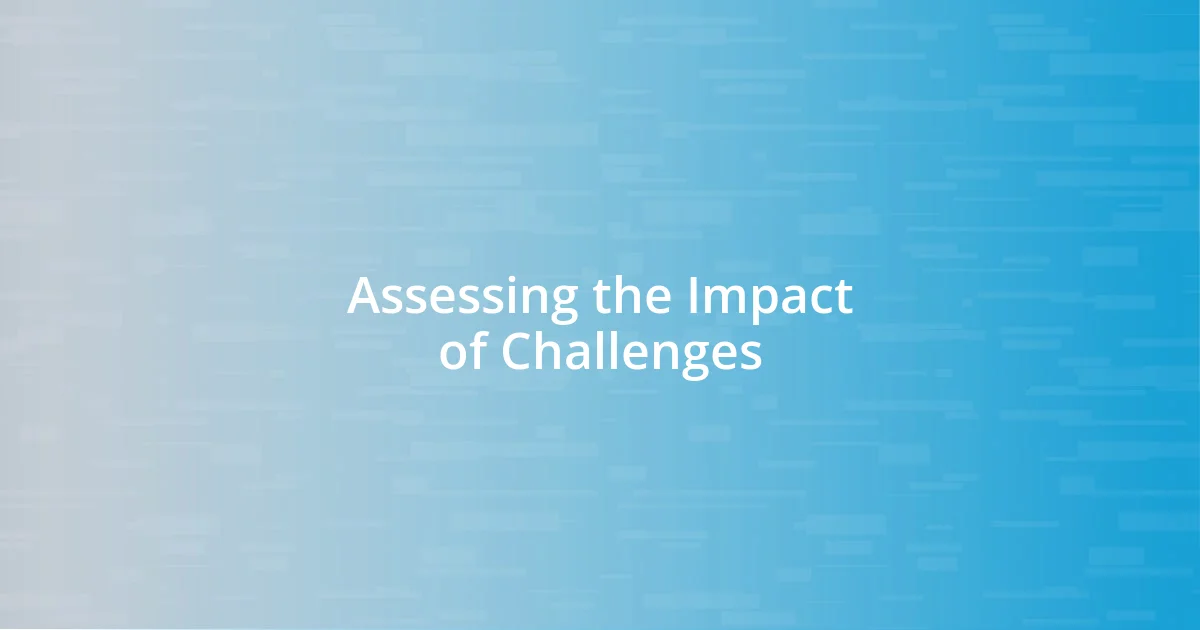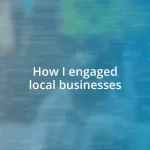Key takeaways:
- Addressing inconsistencies in applicant data and delayed communication greatly improved candidate satisfaction and streamlined the screening process.
- Developing a strategic plan with clear goals and stakeholder engagement transformed chaotic recruitment efforts into a more manageable and efficient workflow.
- Fostering a culture of open dialogue, continuous learning, and adaptability among team members enhanced collaboration and resilience in overcoming screening challenges.

Identifying the Screening Challenges
When I first started tackling screening challenges, I was surprised by the sheer variety of issues that popped up. From logistical setbacks to miscommunication among stakeholders, it felt like navigating a minefield. Have you ever found yourself questioning whether you’ve truly covered all bases? I certainly did.
One specific issue I faced was the inconsistency in applicant data. As I reviewed submissions, I noticed varying formats and missing information that created confusion. It made me wonder how many qualified candidates were slipping through the cracks due to these discrepancies. Reflecting on this made me realize that addressing these inconsistencies wasn’t just important for efficiency, but also essential for fairness in the selection process.
Finally, let’s talk about the emotional aspect of identifying these challenges. Feeling overwhelmed is common when tackling such a complex issue. I remember the pressure I felt as deadlines approached and the fear that I might not deliver a fair and thorough screening process. It was this pressure that pushed me to develop clearer guidelines and better communication practices, transforming a chaotic experience into a more manageable and, ultimately, successful one.

Assessing the Impact of Challenges
When I think about the impact of the challenges I encountered, it becomes clear that each hurdle offered valuable lessons. For instance, I once struggled with time management while trying to coordinate interviews. This led to confusion and frustration for both applicants and interviewers alike. I quickly realized that these challenges not only hindered productivity but also negatively impacted candidate experience, something I couldn’t afford.
One particularly eye-opening moment occurred when I gathered feedback from candidates who faced delays in communication. Their responses highlighted how distressing the uncertainty felt during the waiting period. Not only did their feedback prompt me to reevaluate my response times, but it also opened my eyes to the emotional toll that screening challenges can impose on candidates. This inspired me to create a more transparent process, ensuring applicants felt valued and informed throughout their journey.
It’s fascinating to see how the challenges not only affected my workflow but also enriched my understanding of applicant perspectives. For example, after addressing the inconsistencies in data, I conducted a follow-up survey and was blown away by the improvement in candidate satisfaction. This made me appreciate the profound ripple effect that resolving screening challenges can have, creating a more efficient process while fostering a sense of trust and respect with candidates.
| Challenge | Impact |
|---|---|
| Inconsistency in Applicant Data | Confusion and potential loss of qualified candidates |
| Time Management Issues | Frustration for applicants and interviewers, creating a negative experience |
| Delayed Communication | Increased anxiety and uncertainty for candidates |

Developing a Strategic Plan
Developing a strategic plan was my first step toward gaining control over the overwhelming challenges I faced. Initially, I felt lost, juggling multiple guidelines and conflicting feedback. I recall sitting at my desk late at night, surrounded by notes, trying to outline a coherent strategy. What worked for me was breaking down the process into manageable phases. By doing this, I found clarity and a sense of direction that had previously eluded me.
To create an effective strategic plan, I focused on identifying the core objectives that would guide my actions. Here’s what I prioritized:
- Clear Goals: I set specific, measurable objectives that aligned with the overall mission.
- Timeline: Establishing deadlines helped me stay accountable and motivated.
- Stakeholder Engagement: Involving relevant parties ensured their insights were integrated, fostering collaboration.
- Resource Assessment: I evaluated available resources to maximize efficiency and minimize wastage.
- Continuous Feedback Loop: Implementing regular check-ins allowed me to adapt the plan as needed, reflecting on successes and areas for improvement.
This structured approach was a game-changer for me. By taking a step back and assessing the pieces of the puzzle, I could see not just the hurdles but also potential solutions unfolding before me. The emotional weight of uncertainty began to lift, and I felt empowered to drive the process forward.

Implementing Effective Screening Techniques
Implementing effective screening techniques is crucial to overcoming challenges. One technique that worked wonders for me was leveraging technology to streamline the screening process. I vividly remember the day I first integrated an applicant tracking system. It felt like I had discovered a secret weapon! Suddenly, all applicant data was organized in one place, reducing the confusion that had previously slowed us down. I could easily track communication, making it simple to reach out to candidates promptly.
Another aspect I found essential was training my team on best practices. I reflected on a time when one of my colleagues struggled with assessing candidate qualifications consistently. By organizing a training session that emphasized key evaluation metrics, we not only uplifted their confidence but also improved our collective understanding of what to look for during interviews. Sharing this knowledge fostered a culture of insight and collaboration that profoundly impacted our screening outcomes.
Lastly, I began incorporating holistic assessments into my screening toolkit. While numbers and qualifications matter, I learned that understanding a candidate’s potential fit within our company culture is equally vital. I recall a specific situation where I chose to prioritize a candidate’s soft skills and attitude over their technical experience. This decision led to a remarkable hire who transformed our team dynamics. Have you ever wondered how much potential you might overlook by focusing solely on hard skills? My experience taught me that a well-rounded approach to screening can truly change the game.

Monitoring and Evaluating Progress
Monitoring progress is like having a compass on a journey; it keeps you oriented and focused. I remember the first time I implemented a tracking system for our screening metrics. Each week, I’d sit down with my team to review the data, and I could feel the energy in the room shift as each success story emerged from the numbers. Suddenly, we weren’t just ticking boxes; we were celebrating tangible progress, which fostered a stronger bond among the team.
During this process, I learned that self-reflection is just as crucial as tracking metrics. I would often ask my team, “What did we learn from this?” This simple question opened the door to rich discussions about our experiences and challenges. One memorable moment was when a team member pointed out a recurring mistake in our candidate evaluations. By addressing this issue collaboratively, we not only corrected our course but also strengthened our collective knowledge, making us all more adept at our roles.
It’s easy to overlook the emotional aspects of monitoring progress, yet they can be incredibly motivating. I vividly recall a meeting where we shared both our wins and our setbacks. As I listened to my colleagues share their personal challenges, I realized that every misstep was just a stepping stone toward improvement. Have you ever felt that sense of camaraderie in facing challenges together? It dawned on me that by fostering a culture of open dialogue and continuous learning, we could transform our setbacks into powerful lessons that propelled us forward.

Adapting to New Challenges
Adapting to new challenges often feels like stepping into uncharted territory. I distinctly remember when our team faced an unexpected surge in applicants due to a sudden company expansion. Initially, it felt overwhelming, but we turned that chaos into clarity by swiftly creating a priority matrix. This approach allowed us to focus our attention on candidates who aligned most closely with our immediate needs, ultimately transforming a daunting situation into a targeted plan of action. Have you ever found yourself in a similar whirlwind, only to discover a way to harness it for good?
Emotional resilience plays a pivotal role in adapting. There was a time when I felt discouraged during a particularly intense hiring phase. It seemed like we were missing out on great candidates despite our best efforts. I decided to have candid conversations with my team about the frustrations we faced. Sharing those feelings not only lightened the mood but also spurred innovative ideas. Suddenly, we were brainstorming solutions together, which deepened our connection and made tackling challenges feel less isolating. When was the last time you allowed vulnerability to transform your perspective?
Moreover, I learned that flexibility is key to adaptation. One day, a new recruitment platform was introduced that promised to make our lives easier, but it did come with a learning curve. Rather than resisting the change, I encouraged my team to see it as an opportunity for growth. We scheduled weekly walkthrough sessions, and I was surprised at how quickly we adapted. Those moments became not just training sessions, but team-building exercises that fortified our resolve. How about you? Have you ever experienced a shift that turned into a real catalyst for team unity?

Sharing Best Practices and Insights
Sharing best practices is essential when navigating screening challenges. I find that setting up regular brainstorming sessions with my team has been incredibly fruitful. For instance, during one of these gatherings, we collectively developed a resource guide that detailed effective screening techniques. This guide became our go-to tool, enabling us to standardize best practices and ensuring that everyone was on the same page. Have you ever collaborated on a document that made everyone’s life easier?
Another practice I swore by was creating an environment that encouraged feedback. I remember introducing an anonymous feedback tool to assess our processes. The insights we gained were eye-opening. One piece of feedback highlighted that candidates often felt lost in the process, which prompted us to enhance our communication. It was a moment of realization—the best ideas can often emerge from the most unexpected places, don’t you think?
Lastly, I learned that sharing insights goes beyond just what works. Reflecting on mistakes is equally important. Early on, I was hesitant to admit when we missed the mark during a hiring phase. However, one insightful discussion revealed the importance of embracing these moments as learning opportunities. As we dissected our missteps, not only did we improve our screening criteria, but we also cultivated a culture of trust. Have you ever turned a failure into a stepping stone for growth? It’s a powerful reminder of how shared experiences can lead to greater successes.















